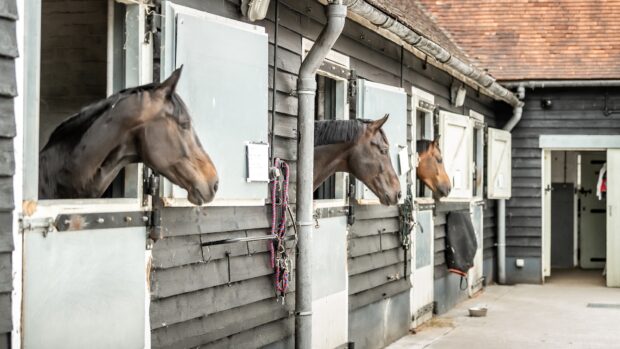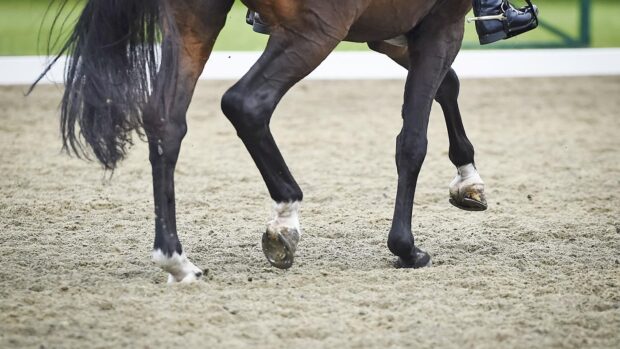The FEI has set out its much-anticipated action plan to ensure “a good life” for equines – but questions remain on whether “the voice of the horse” is being heard.
The first session of the 2024 FEI Sports Forum (29-30 April) was dedicated to discussing the final report of the Equine Ethics and Wellbeing Commission (EEWC), “A good life for horses: a vision for ensuring the future involvement of horses in sport”, presented at the general assembly in November (news, 30 November), and the FEI’s proposed strategy.
FEI president Ingmar de Vos described the session as “the most critical topic” of the forum, and stressed the importance of the industry working together to tackle welfare concerns.
“There will be quick wins, but there will also be things that will take more time for which we will have to undertake scientific research,” he said, adding that instead of writing to the FEI with concerns, stakeholders should “look at what you can do yourself”.
“It’s a shared responsibility and it’s time for action, at every level. A year ago some top athletes told me that the problem is at the lower level, but the cases we have had recently show very clearly it’s not only the lower level. We are as strong as the weakest link, it takes a year to build up a reputation and a minute to destroy it.”
FEI veterinary director Göran Äkerström said the strategy is about “acknowledging and respecting the natural needs of horses within the context of international equestrian sport” – and added that we should no longer be referring to horses as “partners”.
“Partners indicate equal standing, which is not really true. We are their guardians,” he said.
The FEI presented its proposed action plan, a 62-point welfare strategy based on the five domains model, aimed at targeting the EEWCs six priority areas: training and riding and tack and equipment; recognising physical and emotional stress; accountability, enforcement and knowledge; the other 23 hours; competitive drive; and masking health problems. The strategy sets out actions already in place, future ideas, and ways the FEI can collaborate with national federations (NFs) and stakeholders.
Among the many topics tackled was training at home, and the FEI acknowledged that rules and guidelines on acceptable training methods are missing. It was proposed introducing FEI registration for trainers in Olympic disciplines, as is in place in endurance.
“We can train and ensure these people understand their responsibility, and if there are wrongdoings it gives the FEI jurisdiction to potentially open disciplinary proceedings,” FEI legal director Mikael Rentsch.
Hyperflexion (rollkur) came under the spotlight. Mr Äkerström said there are guidelines currently in steward manuals, but more research is needed because it is a complex area, and “there is a lot of division in the community about this”.
“We will resume the work by engaging in discussion with riders, trainers, officials, and scientists, and this will lead to rules, regulations, and education so this becomes more clear,” he said.
The FEI discussed providing NFs with “model rules”, following concerns that the FEI had had to step in on recent horse abuse cases because NF rules “were not solid enough”.
“We want NFs to have a key role in helping us prosecute cases. The other important thing is that there is no statute of limitation – if a case happened five years ago and we only discover it now, we are able to prosecute,” said Mr Rentsch, adding that some NFs have limitations where they cannot take action after a certain period of time.
“It doesn’t look good when a scandal arises if you are not able to act because your rules don’t allow you to. If we provide model rules it will give the right tools to implement them at national level.”
Other proposals included strengthening the FEI equine welfare code of conduct, with collaboration from World Horse Welfare, and ensuring more industry stakeholders commit to the Equestrian Charter, created by the EEWC last year. NFs and stakeholders have until 15 May to provide feedback on the proposals set out so far, ahead of a further action plan being presented at the general assembly in November.
The EEWC was largely “pleased” with the strategy, particularly the integration of the five domains, and the recognition that horses are not equal partners in sport – but concerns were raised that “that sense of welfare” was missing.
“Explicit in the commission’s recommendations was the need for the FEI’s commitment to ensuring horse welfare as a priority,” said EEWC chair Natalie Waran, adding this needed an “overt internal voice for the horse”, and an ongoing independent review via the establishment of a permanent equine ethics and welfare advisory committee.
“As yet this doesn’t appear in the plan. We understand that there will be further discussion regarding those of the 30 recommendations in the final report that have not yet been addressed and we look forward to hearing about further actions, and offer our support in future discussions.”
World Horse Welfare chief executive Roly Owners said it was “encouraging” that the FEI is taking action on the EEWC’s six immediate priority areas – but added that maintaining “a real sense of urgency in addressing all 30 of the recommendations was vital”.
“We believe it is also fundamental for there to be independent external oversight of the FEI’s action plan, as experience shows this is central to the maintenance of social licence, and more importantly should reap faster and more effective improvements to horse welfare,” he said.
You might also be interested in:

Tackling inappropriate horse training at home – industry starts this vital conversation

Leaders urged to be bold and ambitious at ‘crucial moment’ for horse sport

‘A good life for horses’: why equestrian sport’s future rests on all our shoulders, and what are the next steps

Subscribe to Horse & Hound magazine today – and enjoy unlimited website access all year round
Horse & Hound magazine, out every Thursday, is packed with all the latest news and reports, as well as interviews, specials, nostalgia, vet and training advice. Find how you can enjoy the magazine delivered to your door every week, plus options to upgrade your subscription to access our online service that brings you breaking news and reports as well as other benefits.




